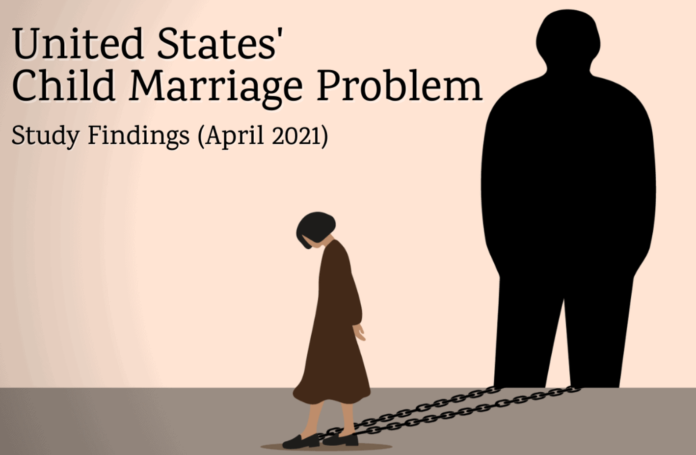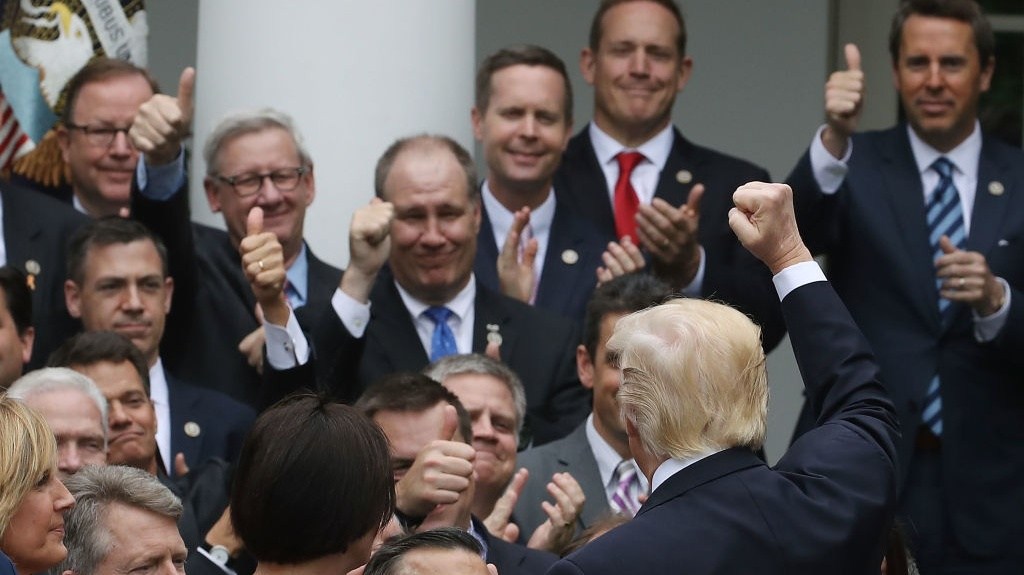By Mariel Padilla/Originally published by The 19th. We’re answering the “how” and “why” of justice news. Sign up for our daily newsletter.
Wearing a bridal gown and chains around her wrists, Fraidy Reiss hopped in an Uber to get to the airport from the Michigan statehouse, where she had just participated in a protest against child marriage.
“For some reason, most Americans do not realize that these abuses are happening,” Reiss said. “Most Americans agree that forced marriage and child marriage are terrible and heartbreaking. They imagine this happening on the other side of the world, and I wish there was something we could do to show them it’s happening here, too, largely because we have outdated, archaic and dangerous laws that need to be updated.”
Nearly 300,000 minors — the vast majority of them girls — were legally married in the United States between 2000 and 2018, according to a 2021 study. Child marriage is defined as any marriage where at least one of the parties is under the age of 18. It was legal in all 50 states until 2018. Ten states have since passed bans to end the practice.
Reiss, who was forced into a marriage at 19, founded Unchained at Last, an advocacy nonprofit, in 2011 to help girls and women stuck in forced marriages. The national number of children married has decreased almost every year since 2000 but is unlikely to reach zero without legislative intervention, Reiss said. The organization raises awareness through wedding dress-clad protesters and efforts at the statehouse level to ban child marriage.
The 19th spoke to advocates and experts about the history of child marriage in the United States, its prevalence and the current debate occurring in statehouses across the country.
Why does the age limit matter?
Child marriages create a “nightmare-ish legal trap,” for minors who don’t have a right to escape from parents planning an unwanted wedding or to leave an abusive spouse or, in some cases, to even enter a domestic violence shelter, Reiss said.
“We’re not arguing that you wake up on your 18th birthday with a newfound wisdom and maturity and the ability to choose a life partner,” Reiss said. “It’s about legal capacity: you wake up on your 18th birthday with legal rights of adulthood.”
There is often little that can be done to legally remove minors from their spouses. The youngest bride Reiss has seen was 10 years old. But helping somebody under the age of 18 run away from home or escape from an abusive situation would likely result in criminal charges for the advocates and anyone who attempted to help.
“Not only do we rarely have a positive outcome, but in many cases what ends up happening is these girls turn to suicide attempts and self-harm,” Reiss said. “We have created a legal situation where I can understand why they would think death is the only way out.”
Frustrated with these obstacles, Reiss said Unchained at Last added an advocacy arm dedicated to ending child marriage through legislation in 2015. The advocates were able to get many states to introduce bills that would prevent the marriage of minors with no exceptions — but not a single state passed any such ban for years.
Which states and territories have passed bans?
Delaware and New Jersey were the first states to completely end child marriage in 2018, followed shortly by American Samoa. The U.S. Virgin Islands, Pennsylvania and Minnesota followed suit in 2020. Rhode Island and New York passed bans in 2021. Massachusetts banned the practice in 2022. Vermont passed a ban in April, and Connecticut and Michigan became the most recent states to end child marriage in June.
Advocates against child marriage have faced pushback in their efforts to end it in red, blue and purple states.
The majority of states have introduced and debated legislation related to child marriage, but most of the bills include exceptions with parental or judicial consent or have a minimum marrying age that is younger than 18. According to Unchained data, 10 states have a minimum marrying age of 17; 23 states have a minimum age of 16; two states have a minimum age of 15; and five states don’t have a minimum age specified at all.
What does child marriage typically look like today, and who is most impacted?
Girls are far more likely to be wed as children than boys: 86 percent of minors wed between 2000 and 2018 were girls, Unchained found, according to data that included gender breakdowns. Both the U.S. State Department and the United Nations have called child marriage and forced marriage human rights abuses.
Elizabeth Alice Clement, a U.S. women’s historian at the University of Utah, said support for child marriage tends to be rooted in conservative or religious beliefs around premarital sexuality and pregnancy. The states with the most child marriages per capita are Nevada, Idaho, Arkansas, Kentucky, Oklahoma, Wyoming, Utah, Alabama, West Virginia and Mississippi.
“Early marriage persists in some places much longer than it does in other more religiously conservative places because girls who are sexually active or become pregnant are seen as shameful to their families,” Clement said. “It even happens sometimes that very young girls are married to men who have statutorily raped them because the sex is seen as more problematic than the rape itself.”
About 60,000 marriages since 2000 involved a child at an age or a marriage with a spousal age difference that would have otherwise been considered a sex crime according to Unchained data, citing state law.
“We do this to girls, but we don’t do it to boys,” Clement said. “If it was a general discomfort with children or adolescents having sex, then there would be gender parity in who had to get married.”
What are proponents saying in favor of child marriage?
Although the United States joined a United Nations’ plan in 2016 to end child marriages by 2030, lawmakers continue to debate the minimum marriage age in statehouses around the country. Those arguing in favor of permitting children to marry often argue that establishing any restrictions will interfere with parental rights or religious liberty.
In Wyoming, Republican lawmakers circulated a letter to constituents earlier this year that argued that preventing children from marriage could discourage teen parents from being able to raise their children under one roof. The lawmakers concluded that the marriage age should align with the age in which children become physically capable of having their own children. In Tennessee, Republicans temporarily sought last year to eliminate any limits on marriage entirely. And in Missouri, a Republican lawmaker earlier this year defended child marriage, supporting parents’ right to choose whom their children marry and when. In West Virginia, a Republican spoke out this year against a proposed child marriage ban because he was a teenager when he was married and worried that young people who wanted to get married would simply travel out of state to do so.
What is the history of child marriage in the United States?
The legacy of child marriage has roots in British common law and reaches back to the American colonies, according to Vivian Hamilton, a professor at William & Mary Law School who has published articles on the history of child marriage, changes in the median marriage age over time and shifting economic and cultural influences.
The minimum marriage age has fluctuated over the centuries: In colonial America it was 12 for girls and 14 for boys — a reflection of English law at the time. The minimum ages remained in place unless specific states enacted laws to replace them.
“In the early years, parents wanted to exercise some control over when and who their children married,” Hamilton said. “It was important with respect to estates and property and ensuring that your girls were going to be marrying into a family where they will be supported.”
At the end of the 19th century and into the 20th century, researchers began to better understand adolescent development and recognized that teenagers may be ill-prepared to assume the familial and financial responsibilities associated with marriage. States began to slowly raise the minimum legal age. Then during World War II, Congress lowered the draft age from 21 to 18, and there was pressure to change the presumptive age of consent — the age one can give meaningful consent — to 18 as well.
In 1970, the Uniform Marriage and Divorce Act — model legislation that states could adopt to standardize what marriage and divorce means — was created. According to the act, the presumptive age of consent is 18, but 16- and 17-year-olds would still be allowed to wed with parental or judicial permission.
How does marrying young impact girls and society?
Mabel van Oranje, a princess of the Netherlands and founder of VOW for Girls, a nonprofit dedicated to ending child marriage globally, said child marriage affects every aspect of a girl’s life. Her education, health, ability to earn money, personal safety and legal rights are often jeopardized.
Girls who marry before they turn 18 are about 50 percent more likely to drop out of high school and four times less likely to finish college. Early teen marriage and dropping out of high school are associated with higher poverty rates later in life. A woman in the United States who marries before they turn 18 is about 31 percent more likely to live in poverty when they get older, when compared to women who delay marriage, according to research published in 2010.
Globally, 12 million girls are married before they turn 18 every year. For every girl that graduates high school in the United States, about six girls are married around the world.
“Once you know there’s a problem as big as child marriage, you can’t unsee it,” Oranje said. “The idea that people are just ignoring it, especially at these big development meetings at the United Nations, for example — that really upsets me.”
But Oranje, who has been working on this issue for more than a decade, has seen communities in several countries shift their culture around child marriage and said she remains optimistic as she sees more donor money going toward ending the practice.
Oranje said she travels frequently and meets with girls and women who have faced early or forced marriages. She asks them: What do you want for your own children?
“The answer is almost always the same,” Oranje said. “They say: ‘I want my daughters and my sons to be able to go to school, and I want my children to be able to decide who they want to marry and when.’ Now that’s not an unreasonable ask. And it’s not just good for those girls, but the world. We all benefit from that.”



































